Everybody needs to eat, so demand for food — especially good food — will never go away. This helps explain why the food industrycontinue ...
Adding some personality to your menu could also be a boon to your brand.
We earn commissions if you shop through the links below. Read more
Written by: Carolyn Young
Carolyn Young is a business writer who focuses on entrepreneurial concepts and the business formation. She has over 25 years of experience in business roles, and has authored several entrepreneurship textbooks.
Edited by: David Lepeska
David has been writing and learning about business, finance and globalization for a quarter-century, starting with a small New York consulting firm in the 1990s.
Published on October 27, 2021

Investment range
$23,750 - $55,750
Revenue potential
$325,000 - $750,000 p.a.
Time to build
1 - 4 months
Profit potential
$39,000 - $75,000 p.a.
Industry trend
Growing
Commitment
Full-time
Here are the most important things to know about when starting a catering business:
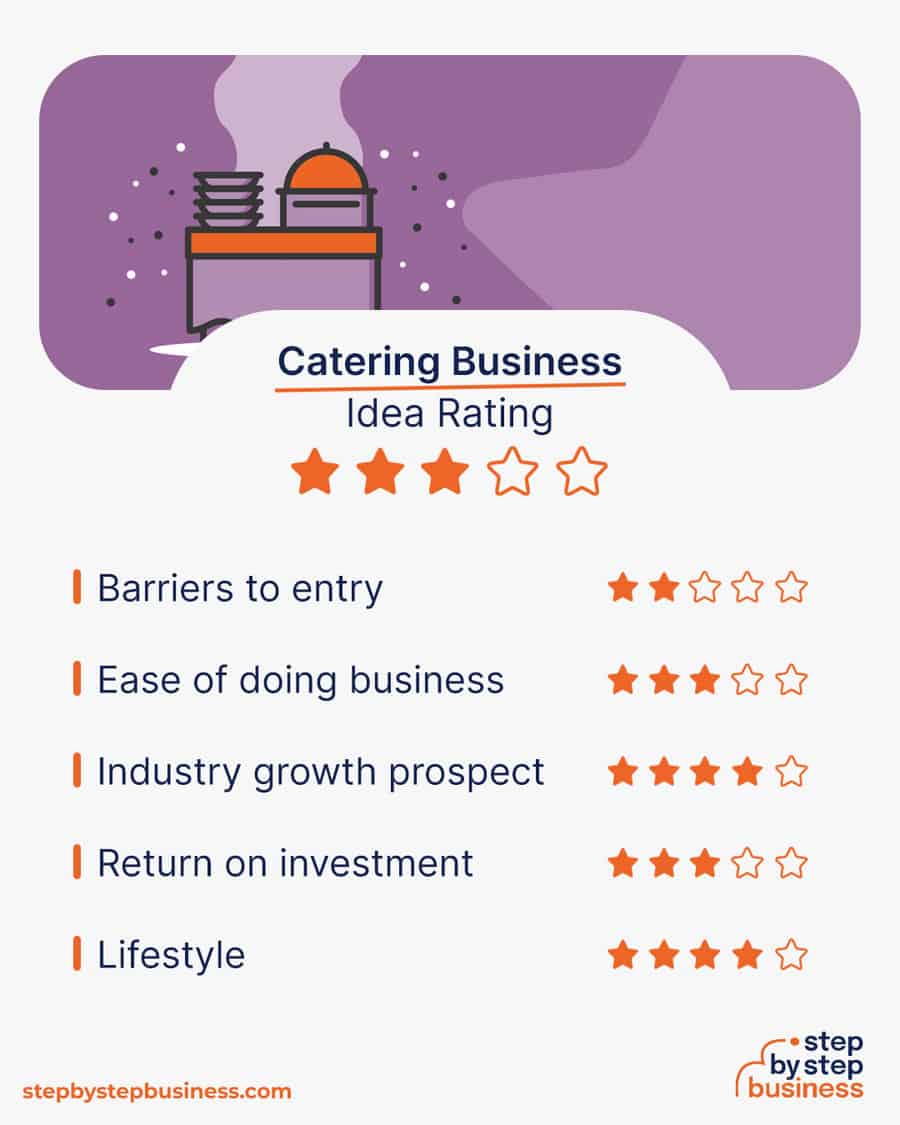
Every business has its advantages and disadvantages, including running a catering business. Weigh each pro and con to find out if catering can work for you.
In the last decade, the catering business has grown faster than the rest of the US economy, benefitting from a larger urban population and more corporate events.
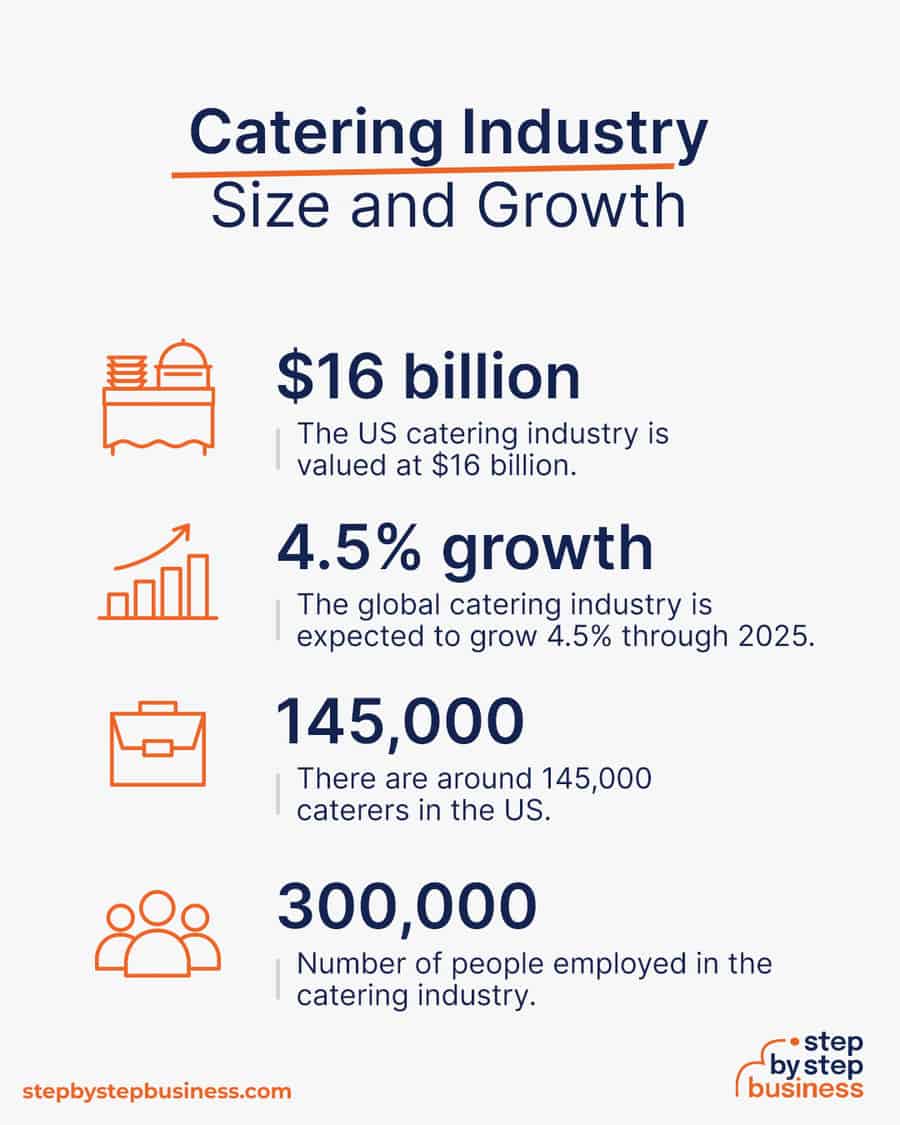
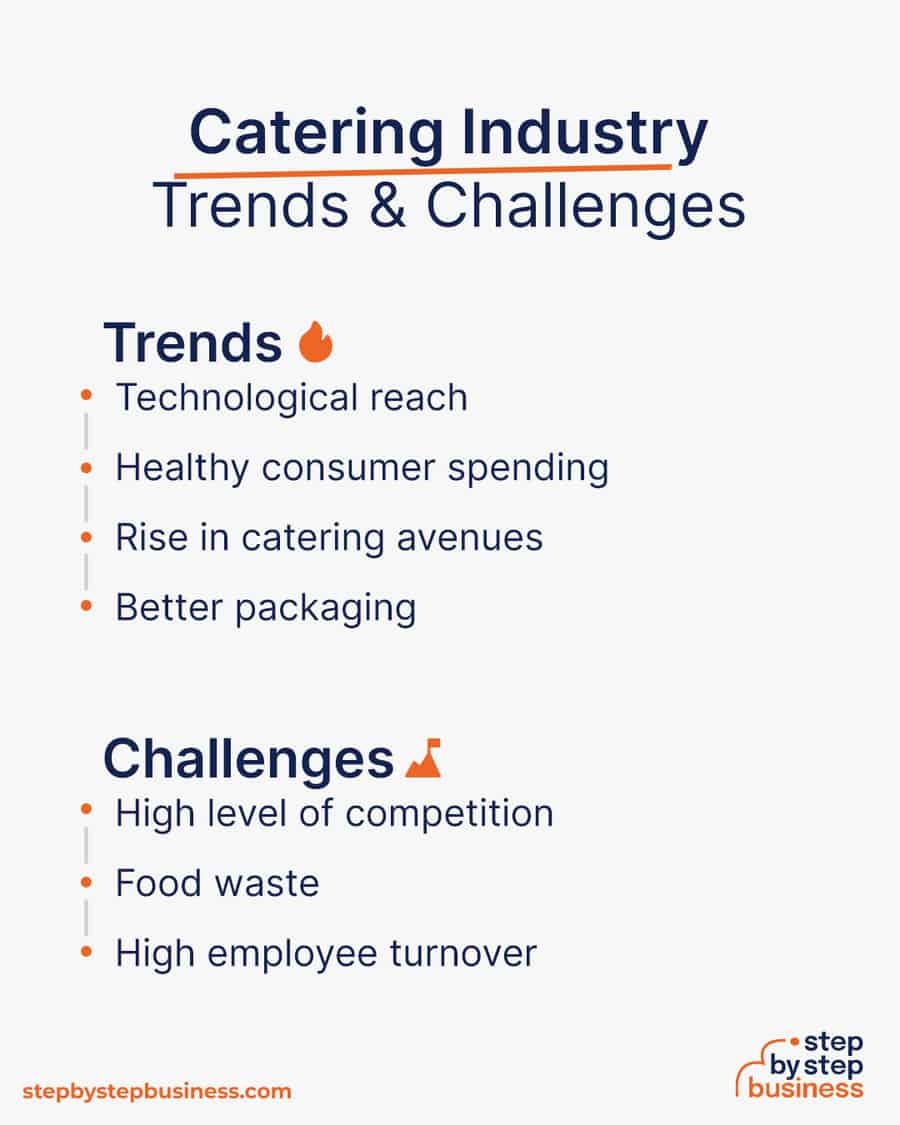
Trends
Tech design and education firm Harbinger Learning((https://harbingerlearning.com/blog/catering-industry-growing-by-leaps-and-bounds-and-sustaining-beyond/)) attributes the industry’s strong growth to four main factors:
Challenges
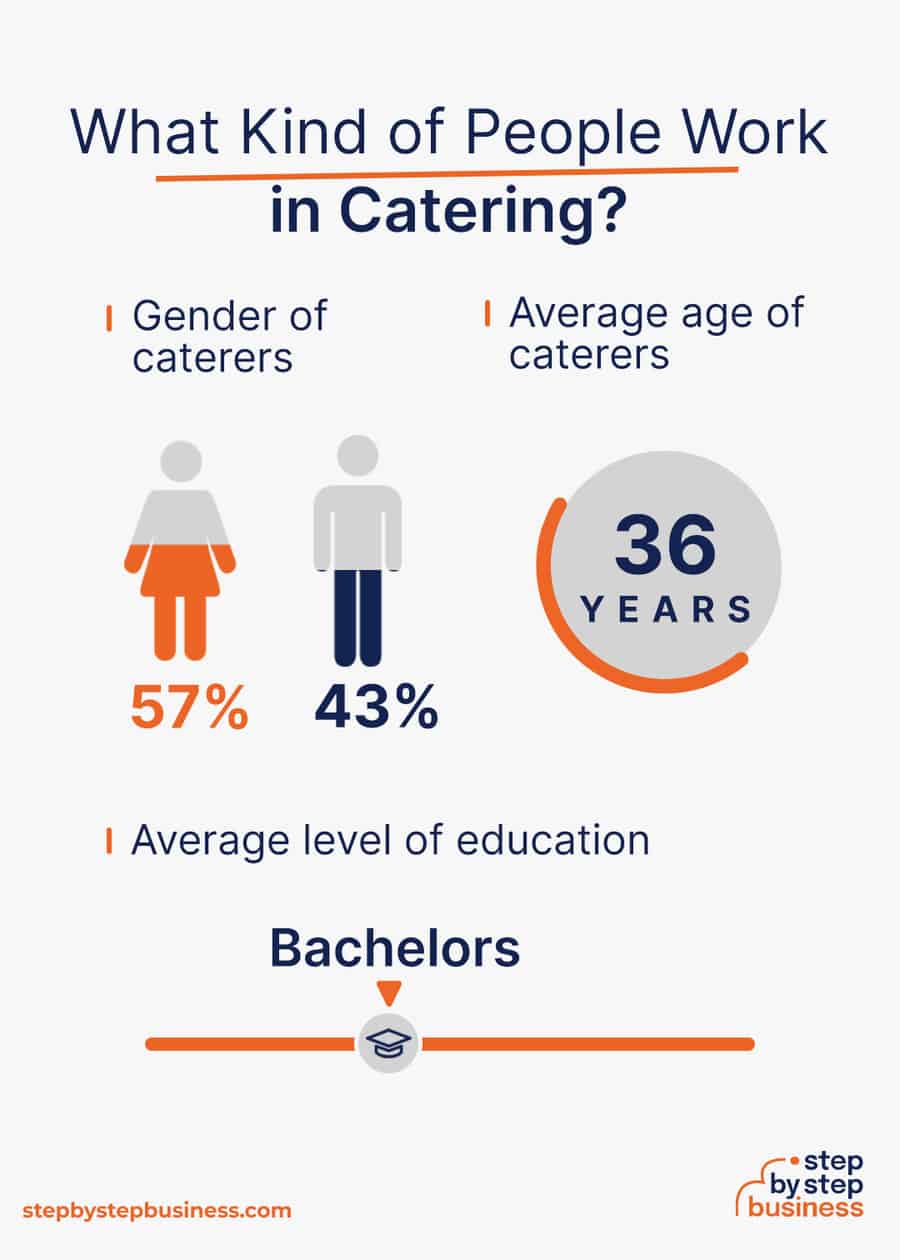
Entrepreneur magazine estimates the startup cost for a catering business at $10,000 to $50,000, with an average of $30,000. The most significant costs include cooking equipment (~$15,000) and potential furniture fixtures such as tables, chairs, and refrigerators (~$15,000). And these costs are likely to increase as your business grows.
The right equipment is crucial for the successful launch of a catering business. You might consider specialty equipment for your particular menu needs. Here’s a list of some of the major items you may need to get started:
Here is an overview of some of the likely startup cost estimates for a catering business in 2021, as compiled by Step by Step Research:
| Start-up Costs | Ballpark Range | Average |
|---|---|---|
| Kitchen/Location | $3,000–$6,000 | $4,500 |
| Licenses and permits | $1,000–$3,000 | $2,000 |
| Staff | $1,000–$4,000 | $2,500 |
| Advertisements | $1,500–$2,500 | $2,000 |
| Insurance | $500–$1,500 | $1,000 |
| Equipment | $15,000–$35,000 | $25,000 |
| Food and beverages | $1,000–$1,500 | $1,250 |
| Training and courses | $500–$1,500 | $1,000 |
| Networking/marketing | $250–$750 | $500 |
| Total | $23,750–$55,750 | $39,750 |
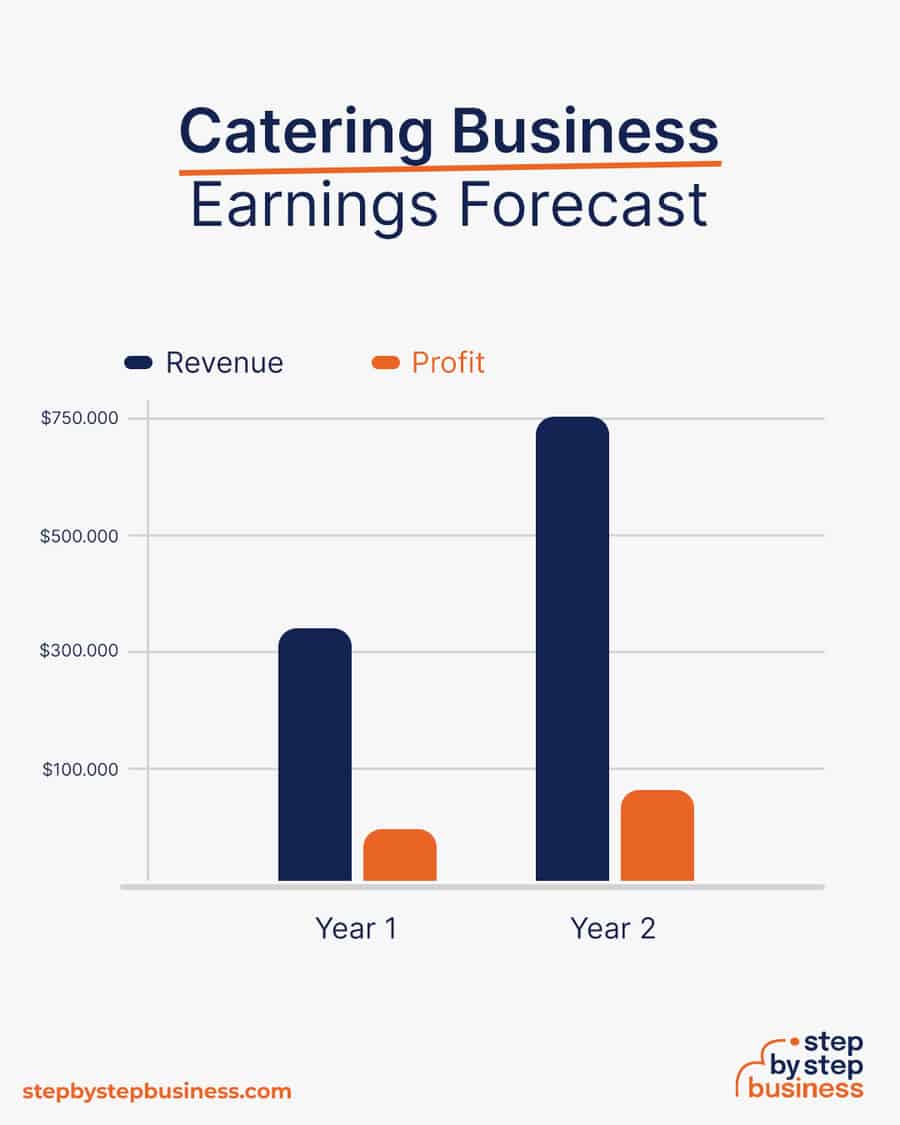
A catering business can expect to make $30,000 to $50,000 in annual profits, with leading jobs site ZipRecruiter putting the national average at just over $42,000. A typical catering firm maintains a profit margin from 10% to 12%, which may be low but is a sizable improvement on restaurants’ 3–6% margin.
Thus, a catering solopreneur could expect to earn $350,000 to $420,000 in annual revenue and $35,000 to $50,000 in net profit. A catering business’s main source of revenue is the per-event fee, which varies depending on the number of people being served and the extent of service.
Event catering can cost clients anywhere from $500 to $3,000 and above, depending on the number of people and the caterer’s market niche. To make $40,000 in annual profit, a catering firm would have to host around 200 events and charge an average of $1,800.
In your first year or two, you could work from home and do 15 events per month for $1,800 per event, bringing in $325,000 in annual revenue. This would mean about $39,000 in profit, assuming that 12% margin. As your brand gains recognition, sales could climb to 25 events per month and you could charge higher at $2,500 per event. At this stage, you’d rent a commercial space and hire staff, reducing your profit margin to 10%. With an annual revenue of $750,000, you’d make a tidy profit of $75,000.
The primary barriers to entry for starting a catering business include:
Now that you know what’s involved in starting a catering business, it’s a good idea to hone your concept in preparation to enter a competitive market.
Market research will give you the upper hand, even if you’re already positive that you have a perfect product or service. Conducting market research is important, because it can help you understand your customers better, who your competitors are, and your business landscape.
To begin as a prospective caterer, you should research your local market to identify what kinds of businesses cater events, what kinds of events those are, and what kind of equipment, fixtures, and logistics such events require.
Consider the most common avenues of wedding catering and corporate catering. Catering is also likely to be used for other special events, such as graduations or birthdays. Alternative niches in the realm of catering might include flowers, tables, or other non-culinary decorations and interior design.
Compare your local market’s needs to the food and beverage menus you’re capable of providing. Do you want to provide full-service, multiple-course meals, or just pastries, cookies, and desserts? Will you serve alcohol? These decisions could necessitate additional planning.
Determine your offerings by researching the most popular food and beverage products at the events you plan to serve. Examples of catering niches include:
Adding some personality to your menu could also be a boon to your brand.
Maybe you provide the best brunch, vegan meals, or mobile dining. Traditional or cultural dishes could be popular in your market.
Consider how you’d like your dishes served — on plates, by servers, or in boxes. There are many options for your choice of food and its delivery. It is best to consider your market relative to your capabilities, both in terms of skill and equipment.
Generally, catering services charge based on the size of the event. You should structure your pricing plan based on your expected expenses. Whether you are preparing mass meals or just delivering treats, you need to weigh labor and ingredient costs against your desired profit margin (avg. 10–12%).
Search site Thumbtack provides a handy guide on catering costs on a per-person basis. Their rates for weddings and other common events include the prices customers should expect to pay. On average, for the most common food station or buffet-style catering, they calculate that the customer will pay around $30 per head:
| # of People | Total Cost | Cost Per Person |
|---|---|---|
| 0-20 people | $540 | $27 |
| 21-30 people | $960 | $32 |
| 31-40 people | $1,240 | $31 |
| 41-50 people | $1,520 | $30 |
| 51-60 people | $1,800 | $30 |
| 61-70 people | $2,090 | $30 |
| 71-80 people | $2,370 | $30 |
| 81-90 people | $2,650 | $29 |
| 91-100 people | $2,930 | $29 |
For high-end food and services, the prices will, of course, be higher. Formal plated meals with multiple courses, for instance, require more preparation time and more expensive ingredients. Here are some more example prices from Thumbtack:
| Catering service | Cost per person |
|---|---|
| Formal dinner | $145 per person |
| Informal food stations | $25 - $45 per person |
| Buffet | $23 per person |
| Corporate event | $70 per person |
Depending on your target market and specific catering offerings, this should get you started in brainstorming your own pricing plan.
Once you know your costs, you can use our profit margin calculator to determine your markup and final price points. Remember, the prices you use at launch should be subject to change if warranted by the market.
Your target market — whether it’s corporations, weddings, or another niche — will have different demands. You should adjust your menu and your services accordingly.
For example, weddings and rehearsal dinners are more likely to make specific requests and ask for certain dishes. Corporate events may be more informal, with generic food requests or adherence to your menu offerings.
If you are ready to customize your menu and include a capacity for your cooks to accommodate unique wishlists for meals, then perhaps you should seek out weddings, bar mitzvahs, and other personalized celebrations. If you intend for your meals to be more standardized, boxed, and templated, then corporate events and conferences may be a better fit. If you want to make extravagant meals fit for fine dining, then you should pursue the higher-end clientele looking for that type of service.
You should understand going in, no matter what type of cook you are, your menu will largely be determined by the desires of your target market.
In the early stage of business development, you may want to operate your business from your home, assuming your kitchen is big enough. This will help you keep expenses in check.
But as your business grows, you’ll likely need to hire workers for various roles and may need to rent out a physical storefront. You can find commercial space to rent in your area on sites such as Craigslist, Crexi, and Instant Offices.
When choosing a commercial space, you may want to follow these rules of thumb:
Here are some ideas for brainstorming your business name:
Discover over 450 unique catering business name ideas here. If you want your business name to include specific keywords, you can also use our catering business name generator. Just type in a few keywords, hit Generate, and you’ll have dozens of suggestions at your fingertips.
Once you’ve got a list of potential names, visit the website of the US Patent and Trademark Office to make sure they are available for registration and check the availability of related domain names using our Domain Name Search tool below. Using “.com” or “.org” sharply increases credibility, so it’s best to focus on these.
Finally, make your choice among the names that pass this screening and go ahead with domain registration and social media account creation. Your business name is one of the key differentiators that set your business apart. Once you pick your company name and start with the branding, it is hard to change the business name. Therefore, it’s important to carefully consider your choice before you start a business entity.
Here are the key components of a business plan:

If you’ve never created a business plan, it can be an intimidating task. You might consider hiring a business plan specialist to create a top-notch business plan for you.
Registering your business is an absolutely crucial step — it’s the prerequisite to paying taxes, raising capital, opening a bank account, and other guideposts on the road to getting a business up and running.
Plus, registration is exciting because it makes the entire process official. Once it’s complete, you’ll have your own business!
Your business location is important because it can affect taxes, legal requirements, and revenue. Most people will register their business in the state where they live, but if you are planning to expand, you might consider looking elsewhere, as some states could offer real advantages when it comes to catering.
If you’re willing to move, you could really maximize your business! Keep in mind that it’s relatively easy to transfer your business to another state.
Businesses come in several varieties, each with its pros and cons. The legal structure you choose for your catering business shapes your taxes, personal liability, and business registration requirements, so it’s important to choose wisely.
Here are the main options:

We recommend that new business owners choose LLC as it offers liability protection and pass-through taxation while being simpler to form than a corporation. You can form an LLC in as little as five minutes using an online LLC formation service. They will check that your business name is available before filing, submit your articles of organization, and answer any questions you might have.
Choose Your State
The final step before you’re able to pay taxes is getting an Employer Identification Number or EIN. You can file for your EIN online or by mail/fax. Visit the IRS website to learn more.
Once you have your EIN, you’ll need to choose your tax year. Financially speaking, your business will operate on a calendar year (January–December), or a fiscal year, a 12-month period that can start in any month. This will determine your tax cycle, while your business structure will determine which taxes you’ll pay.
The IRS website also offers a tax-payers checklist, and taxes can be filed online.
It is important to consult an accountant or other professional to help you with your taxes to ensure you are completing them correctly.
Securing financing is your next step and there are plenty of ways to raise capital:
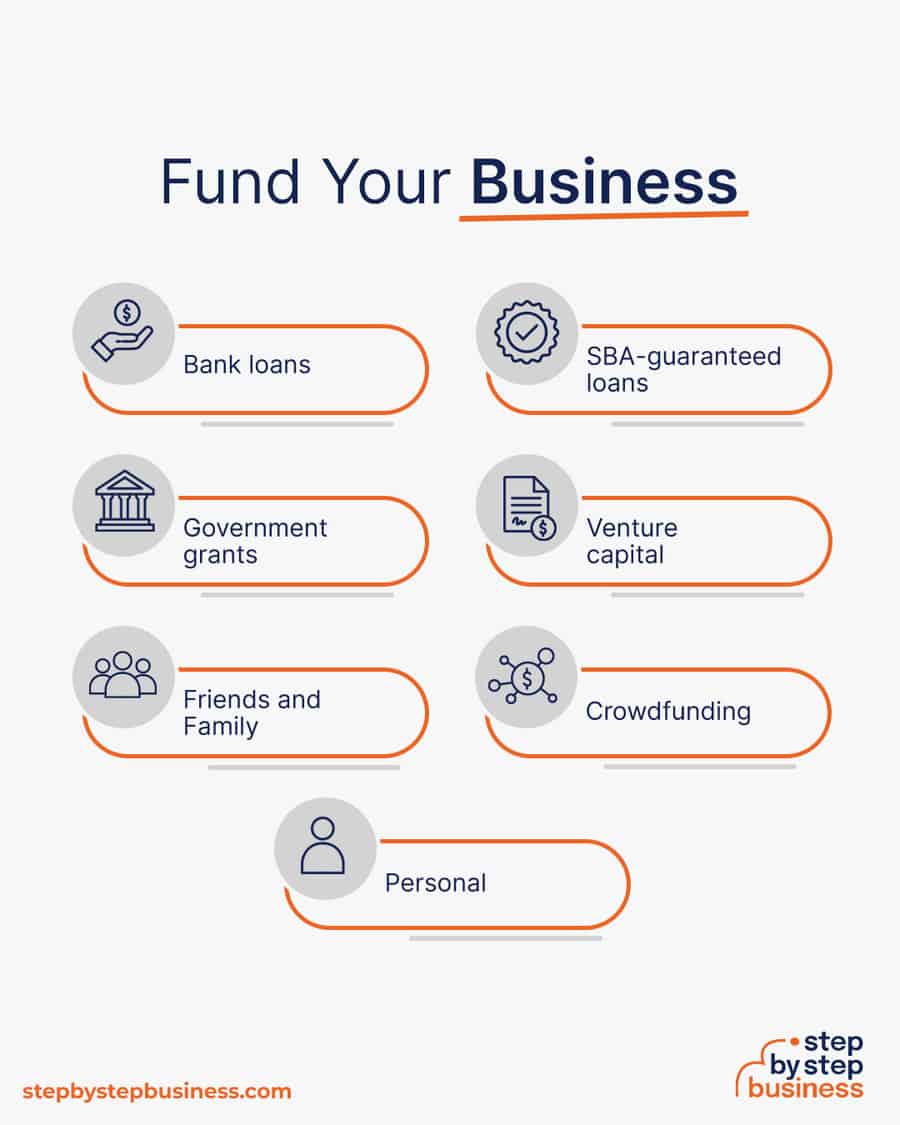
Bank and SBA loans are probably the best options, other than friends and family, for funding a catering business. You might also try crowdfunding if you have an innovative concept.
Starting a catering business requires obtaining a number of licenses and permits from local, state, and federal governments.
Federal regulations, licenses, and permits associated with starting a catering business include doing business as (DBA), health license and permit from the Occupational Safety and Health Administration (OSHA), trademarks, copyrights, patents, and other intellectual properties, as well as industry-specific licenses and permits.
For a catering business, you will potentially need state-level licenses, a business license, and local county or city-based health and food-handling licenses and permits. If you plan to serve alcohol, you will need to obtain a liquor license as well.
Additional permits may be required by your state, such as a general business permit or license. The license requirements and how to obtain them vary from state to state, so check your state government’s website or contact the appropriate person to inquire about licenses and permits needed to run a catering business.
You could also check this SBA guide for your state’s requirements, but we recommend using MyCorporation’s Business License Compliance Package. They will research the exact forms you need for your business and state and provide them to ensure you’re fully compliant.
This is not a step to be taken lightly, as failing to comply with legal requirements can result in hefty penalties.
If you feel overwhelmed by this step or don’t know how to begin, it might be a good idea to hire a professional to help you check all the legal boxes.
Before you start making money, you’ll need a place to keep it, and that requires opening a bank account.
Keeping your business finances separate from your personal account makes it easy to file taxes and track your company’s income, so it’s worth doing even if you’re running your catering business as a sole proprietorship. Opening a business bank account is quite simple, and similar to opening a personal one. Most major banks offer accounts tailored for businesses — just inquire at your preferred bank to learn about their rates and features.
Banks vary in terms of offerings, so it’s a good idea to examine your options and select the best plan for you. Once you choose your bank, bring in your EIN (or Social Security Number if you decide on a sole proprietorship), articles of incorporation, and other legal documents and open your new account.
Business insurance is an area that often gets overlooked but is vital to your success as an entrepreneur. Insurance protects you from unexpected events that can have a devastating impact on your life and business.
Here are some of the different types of insurance to consider:

As opening day nears, prepare for launch by reviewing and improving some key elements of your business.
Being an entrepreneur often means wearing many hats, from marketing to sales to accounting, which can be overwhelming. Fortunately, a number of excellent software programs and digital tools can help you with many business tasks.
Several catering-specific websites and online tools can strengthen your business and boost efficiency. Here’s a list of top catering software offerings:
Website development is crucial because your site is your online presence and needs to convince prospective clients of your expertise and professionalism.
You can create your own website using website builders. This route is very affordable, but figuring out how to build a website can be time-consuming. If you lack tech savvy, you can hire a web designer or developer to create a custom website for your business.
However, people are unlikely to find your website unless you follow Search Engine Optimization (SEO) practices. These are steps that help pages rank higher in the results of top search engines like Google.
Here are some powerful marketing strategies for your future business:

Unique selling propositions, or USPs, are the characteristics of a product or service that set it apart from the competition. Today’s customers are inundated with buying options, so you’ll have a real advantage if they are able to quickly grasp how your catering service meets their needs or wishes. It’s wise to do all you can to ensure your USPs stand out on your website and in your marketing and promotional materials, stimulating buyer desire.
Global pizza chain Domino’s is renowned for its USP: “Hot pizza in 30 minutes or less, guaranteed.” Signature USPs for your catering business could be:
You may not like to network or use personal connections for business gain but your personal and professional networks likely offer considerable untapped business potential. Maybe that Facebook friend you met in college is now running a catering business, or a LinkedIn contact of yours is connected to dozens of potential clients. Maybe your cousin or neighbor has been working in a catering company for years and can offer invaluable insight and industry connections.
The possibilities are endless, so it’s a good idea to review your personal and professional networks and reach out to those with possible links to or interest in catering. You’ll probably generate new customers or find companies with which you could establish a partnership. Online businesses might also consider affiliate marketing as a way to build relationships with potential partners and boost business.
You may not need to hire any employees if you are starting with a small catering firm that’s run out of your kitchen. But as your business grows, you will likely need full-time employees to fill various job roles, such as:
Your business may at some point need to hire all of these positions, or just one or two of them, depending on the size and needs of your business. You might also hire multiple workers for a single role or a single worker for multiple roles, again depending on need.
Free-of-charge methods to recruit employees include posting ads on popular platforms such as LinkedIn, Facebook, or Jobs.com. You might also consider a premium recruitment option, such as advertising on Indeed, Glassdoor, or ZipRecruiter. Further, if you have the resources, you could consider hiring a recruitment agency to help you find talent.
Higher consumer spending and corporate marketing budgets bode well for a catering business, so be prepared to step up once the opportunity comes knocking.
To jumpstart word-of-mouth marketing, it’s wise to identify a niche market, such as product launches, meetings and conferences, and other corporate events. But you might also want to keep your options open and cater to a broader client base. Either way, cooking up a diverse and appealing menu is important to keep clients satisfied and inspire their loyalty.
You’re now ready to launch your catering business and start your entrepreneurial journey. Good luck!
You’ll need general business permits like zoning and sales tax licenses, along with food-specific licenses from your state. Depending on your menu, you might also need to register with the Food & Drug Administration. It’s important to research your specific requirements. Local health departments are key resources for obtaining the necessary permits and licenses.
You don’t need your own facility; consider using your home kitchen or renting a professional kitchen. Options include incubator kitchens designed to support new food businesses, co-packer kitchens for contract production, co-renting with other caterers, or using a restaurant’s kitchen during off-hours. Resources like The Kitchen Door can help you find these options.
Food business owners should first and foremost understand the various food safety protocols, such as Hazard Analysis and Critical Control Points (HACCP), Good Manufacturing Practices (GMP), and the Global Food Safety Initiative (GFSI). In general, preparing, packaging, and labeling your food appropriately is necessary to comply with food safety protocols.
The profitability of running a catering business can vary depending on factors such as target market, pricing strategy, and operational efficiency. Successful catering businesses have the potential for high-profit margins, but careful cost management and effective operations are crucial for profitability.
To attract more clients for your catering business, network with event planners and other professionals in the industry, build a strong online presence with an impressive website and social media profiles, encourage satisfied clients to provide testimonials or reviews, collaborate with local businesses for partnerships, and create appealing marketing materials.
When organizing a catering menu, consider your target market’s preferences, offer diverse options to accommodate dietary restrictions, consider seasonality and ingredient availability, create customizable menu packages, pay attention to presentation, seek client feedback, and regularly update your menu based on preferences and market trends.

Published on July 21, 2022
Everybody needs to eat, so demand for food — especially good food — will never go away. This helps explain why the food industrycontinue ...
Read Now

Published on June 30, 2022
People are always eating and drinking, so starting a food business is always a potentially wise career choice. But to succeed you’ll need astr ...
Read Now

Published on June 8, 2022
Food trucks have exploded in popularity in recent years and offer a unique, potentially lucrative alternative to brick-and-mortar restaurants. Foodt ...
Read Now
No thanks, I don't want to stay up to date on industry trends and news.
Comments